Squash & Apple Puree
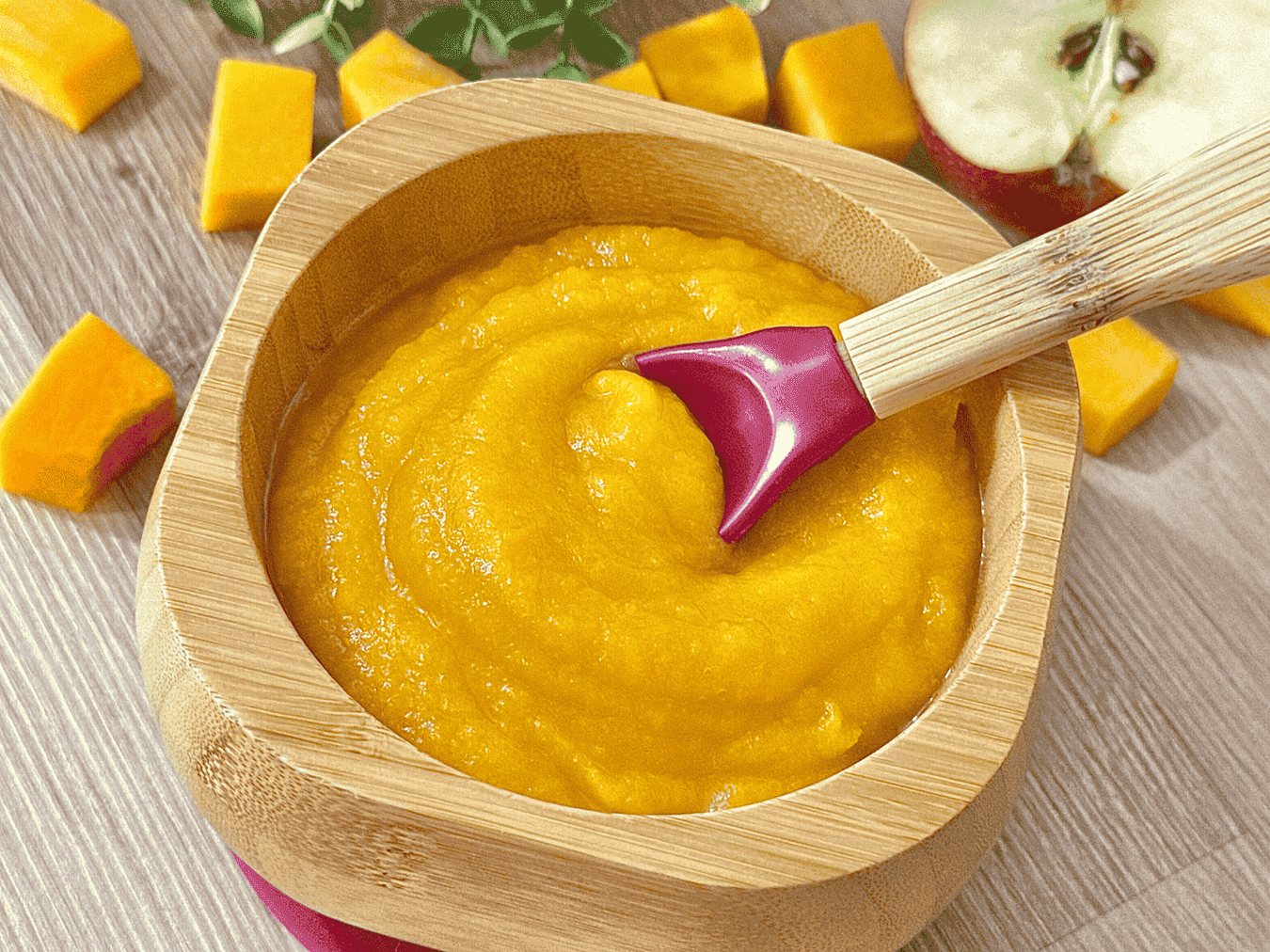
Written by Kenny Ekerin
Fact Checked by Mindsmaking Professionals
10th, September, 2025
This post may contain affiliate links. Please read our disclosure policy.
Homemade baby food feels like a little love in every spoonful. This squash & apple purée is a cozy first food for 6+ months—naturally creamy, gently sweet, and packed with goodness
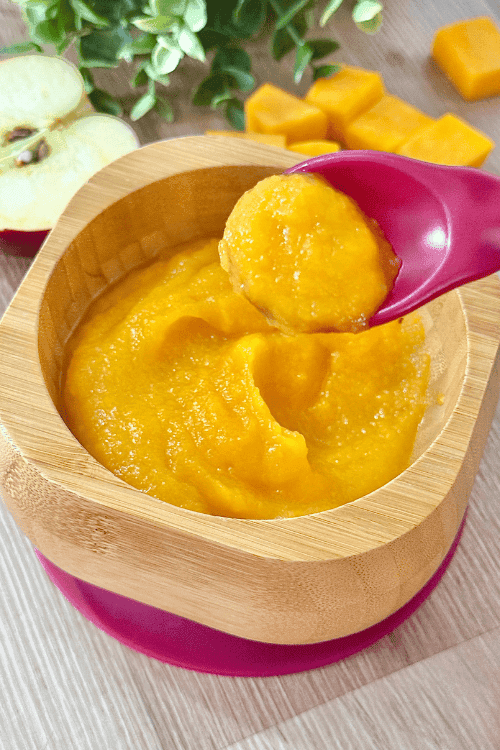
There’s something so heartwarming about making your own baby food, it feels like serving a spoonful of love in every bite. This squash & apple purée recipe is a gentle and nourishing first food for babies 6 months and up. With the natural creaminess of butternut squash and the sweet brightness of apples, it’s as delicious as it is wholesome.
Not only is it rich in vitamin A for healthy eyes and skin and vitamin C to support immunity, but it also provides gentle fiber to aid tiny tummies. The best part? It’s so versatile as you can keep it silky smooth for little beginners or mash it lightly for older babies exploring texture. Plus, it doubles as a tasty mix-in for oatmeal, or yogurt.
Why You’d Love This Baby Puree
- Perfect texture for babies learning to eat.
- Easy for toddlers to self-feed with a spoon.
- Full of natural nutrients from whole ingredients.
- Make once, serve multiple times as it is freezer-ready.
- Makes fruits fun and approachable for hesitant eaters.
Prep time: 5 minutes
Cook time: 17 minutes
Yields: 4–5 portions
How to Make This Squash & Apple Puree
Ingredients
- ½ medium butternut squash, peeled, deseeded, and cubed
- 3 apples (sweet varieties like Gala or Fuji work best)
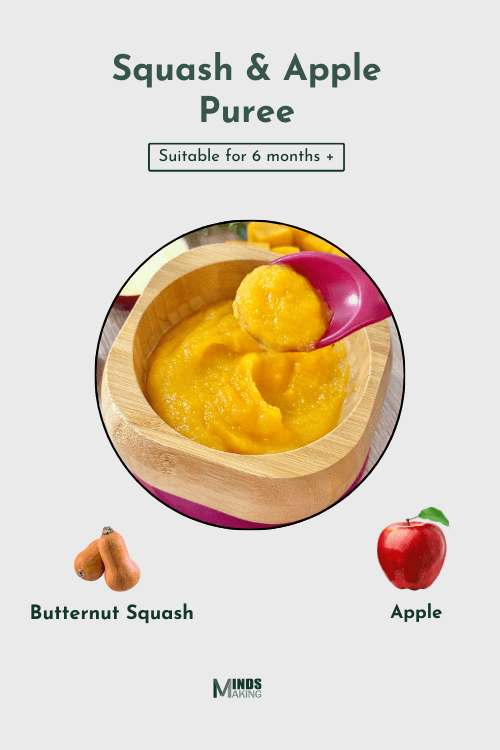
Read This Next

Recipe Ebook
Essential Guide to Starting Solids for Babies 6 Months+ - LBH Top 70 Baby Puree & Porridge Recipes eBook.
Start your baby’s solids journey with confidence using this "70 Baby Purees & Porridges" eBook! Created with care, this digital guide is packed with nutrient-rich recipes for babies 6 months and older, including purees and porridges tailored to each stage of your baby’s development.
Instructions
1. Prep the squash: Peel your butternut squash, scoop out the seeds, and cut it into small cubes. Smaller pieces cook faster and more evenly.
2. Start steaming: Place the squash cubes into a steamer basket and steam for about 10 minutes until they begin to soften.
3. Add the apples: Peel, core, and dice the apples. Add them to the steamer with the squash and continue steaming for another 7 minutes, or until both squash and apples are fully tender.
4. Blend to your baby’s stage: Transfer the mixture into a blender, food processor, or use an immersion blender. Purée until smooth for young babies, or leave slightly textured for older babies.
5. Cool and serve: Allow the purée to cool before serving. Store leftovers in the fridge or freezer for future meals.
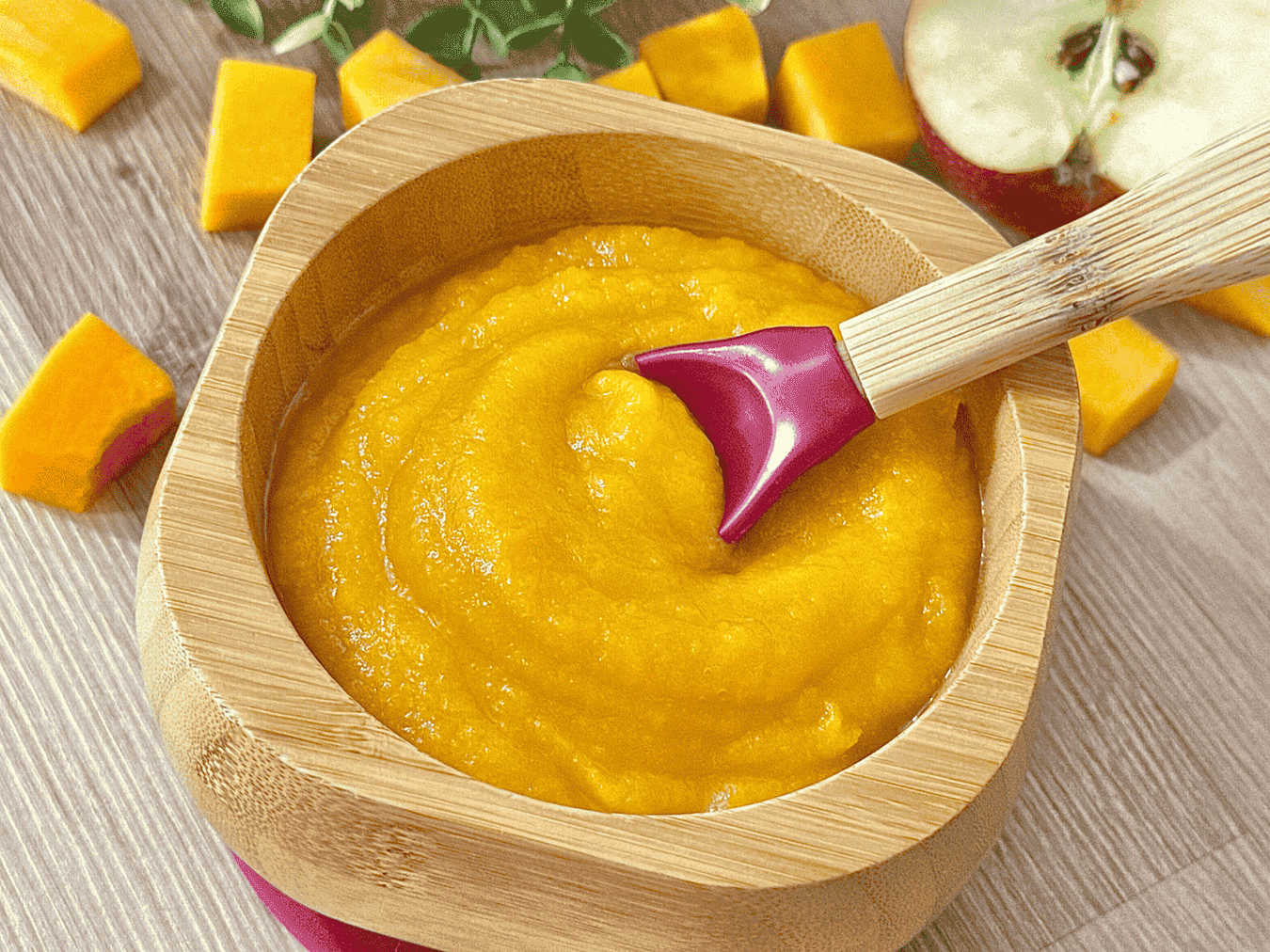
Tips for success
Steam until very tender
Babies just starting solids need food that is completely soft to prevent choking. Test readiness by poking a piece with a fork; it should slide through effortlessly. If it still feels firm or slightly crunchy, give it more steaming time.
Choose naturally sweet apples
Squash can sometimes lean earthy, so pairing it with naturally sweet apples like Gala, Fuji, or Honeycrisp creates a flavor balance babies love. Avoid tart apples, as the sourness can be off-putting for little taste buds.
Adjust texture based on age
For babies around 6 months, blend into a silky purée with no lumps. As your baby gets to 8–9 months+, leave small soft chunks to encourage chewing practice. For toddlers, you can even mash it with a fork for a more rustic texture.
Batch cook for ease
Making baby food daily can feel overwhelming. By steaming a larger batch and freezing it in ice cube trays, you’ll have pre-portioned purée cubes ready to defrost in seconds. This saves time and reduces food waste.
Serving suggestions
For babies (6–8 months): Offer plain purée on a spoon or mix a small amount into baby oatmeal, rice cereal, or quinoa to introduce new flavors gradually.
For older babies (8–12 months): Mix into plain Greek yogurt for extra protein, spread on soft toast fingers for self-feeding, or combine with mashed avocado for a nutrient-dense snack.
For toddlers: Use it as a natural “jam” on pancakes, waffles, or toast, stir it into pasta sauces for hidden veggies, or serve as a creamy side dish alongside fish, chicken, or lentils.
For adults: This purée doubles as a smooth, naturally sweet side dish. It pairs beautifully with roasted chicken, pork, or grain bowls. For a cozy twist, swirl into soups or blend with warm spices like cinnamon and nutmeg for a fall-inspired side.
How to store
In the fridge: Store leftovers in an airtight container for up to 3 days. Always let the purée cool completely before refrigerating to avoid condensation, which can water it down.
In the freezer: Freeze in ice cube trays or silicone baby food molds for easy single-portion servings. Once frozen, transfer cubes to a freezer-safe bag or container to save space. Label with the date so you know when to use them, ideally within 3 months for the best flavor and nutrient quality.
Thawing & reheating: To serve, thaw cubes overnight in the fridge or place them in a small saucepan and warm gently over low heat. Always stir well and test the temperature before serving to your baby. Avoid reheating more than once, as repeated warming can increase the risk of bacteria growth.
Nutrition
(per serving, approximate)
- Calories: 115kcal
- Carbohydrates: 30g
- Protein: 1.6g
- Fat: 0.4g
- Saturated Fat: 0.06g
- Polyunsaturated Fat: 0.11g
- Monounsaturated Fat: 0.02g
- Trans Fat: 0g
- Cholesterol: 0mg
- Sodium: 6mg
- Potassium: 560mg
- Fiber: 4.8g
- Sugar: 13.8g
- Vitamin A: 13,286IU
- Vitamin C: 31.9mg
- Calcium: 67mg
- Iron: 1mg
Note: Nutritional values are estimates and may vary based on ingredient size, variety, and portion sizes.
Frequently Asked Questions
Can I use a different type of squash?
Yes! Butternut squash is naturally creamy and sweet, but acorn squash, kabocha, or even pumpkin are excellent substitutes. Keep in mind that cooking times may vary, as denser squash varieties may take longer to soften.
Do I have to steam, or can I roast?
Steaming is the most baby-friendly option because it keeps the flavor mild and preserves more vitamin C. However, roasting enhances sweetness through caramelization, which many toddlers and adults enjoy. If you choose roasting, ensure the squash and apples are still fully soft before blending.
Is this safe for baby-led weaning?
Yes! For a spoon-fed purée, let your baby self-feed with a pre-loaded spoon. For a finger food approach, mash lightly and spread on toast fingers, or serve as a thick mash your baby can scoop with their hands. Always supervise closely.
Can I mix this with other foods?
Yes! This purée is versatile. Stir it into baby cereals, oatmeal, yogurt, or savory bases like lentils and quinoa. For toddlers, it’s great hidden in pasta sauces or baked goods like muffins for extra nutrients.
What if my baby doesn’t like it at first?
It’s normal for babies to reject a new flavor the first few times. Research shows babies often need 8–10 exposures to accept a new food. Keep offering small tastes without pressure. You can also mix it with a familiar favorite like applesauce or sweet potato purée to make the transition easier.
Was this article helpful?
How many stars are you giving this article?
Leave a comment
Your email address will not be published.
Comments
More From Recipe

Homemade Mango Yogurt Popsicles
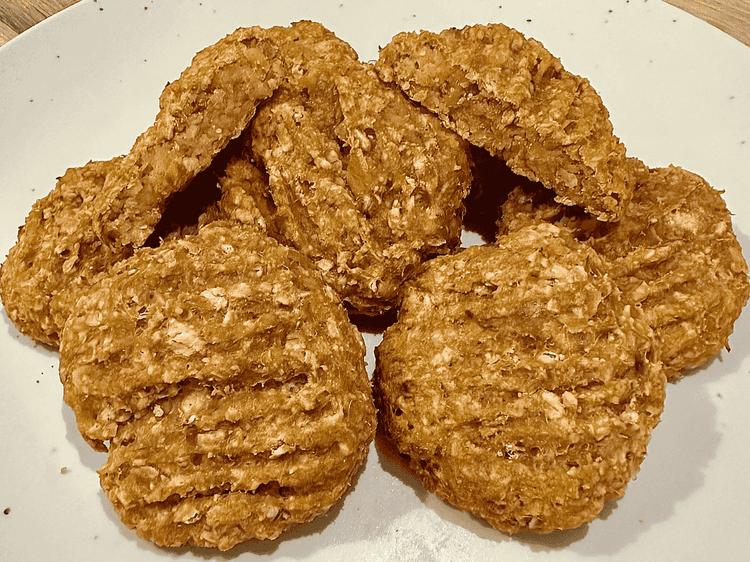
Banana Sweet Potato Cookies

Cheesy Carrot Waffles
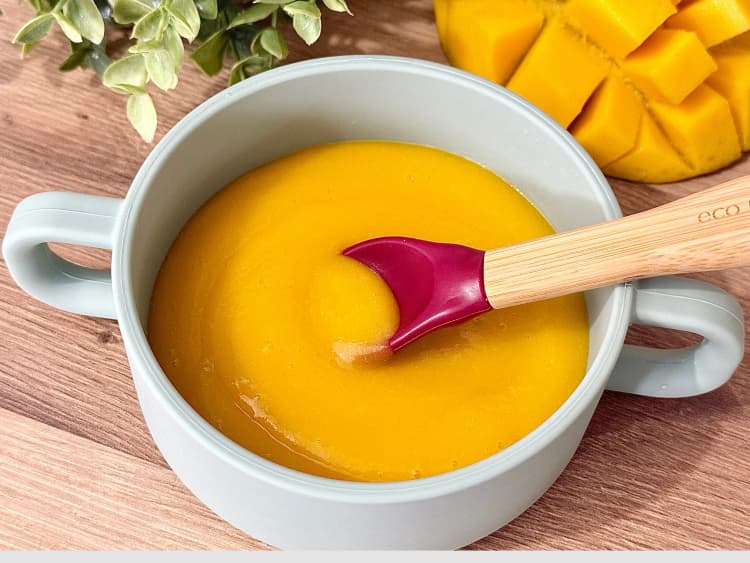
Easy Mango purée

Berry, Banana & Pear Purée

Beet, Strawberry, and Banana Smoothie
Get new recipes to your inbox
Subscribe to our weekly newsletter and get new recipes sent to your inbox!